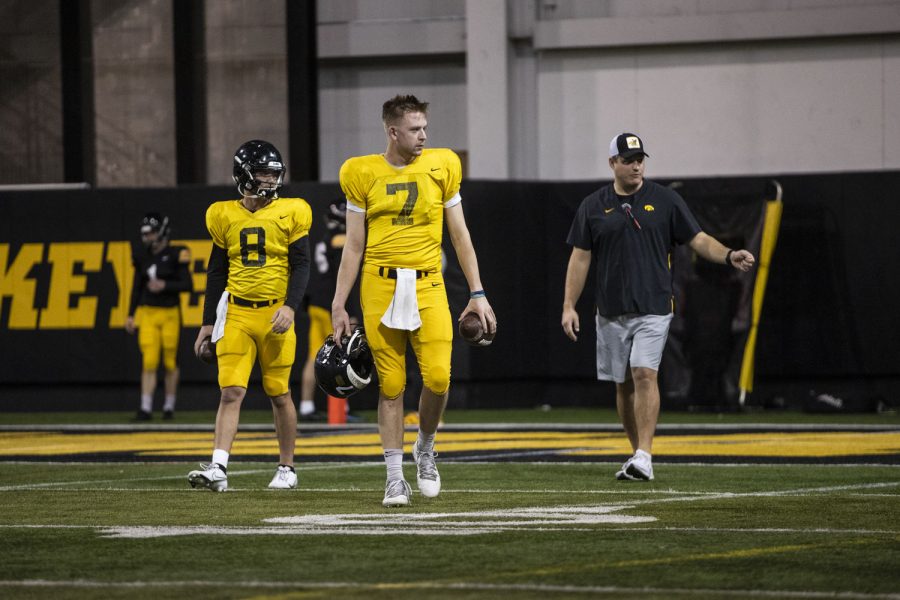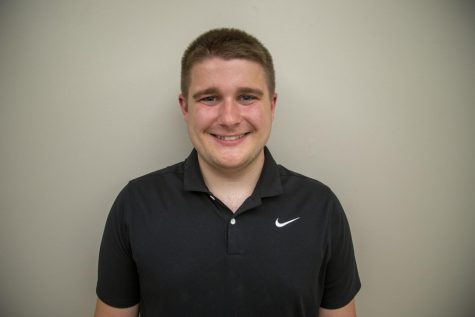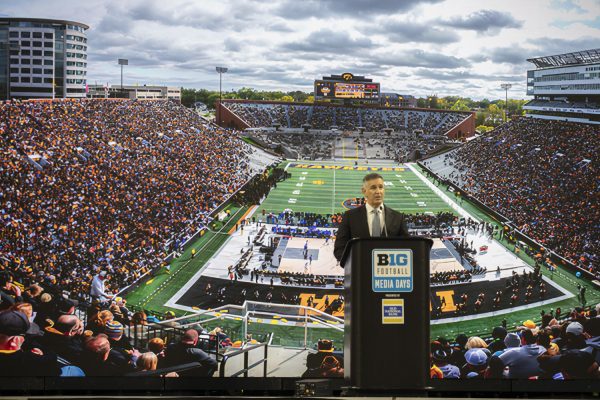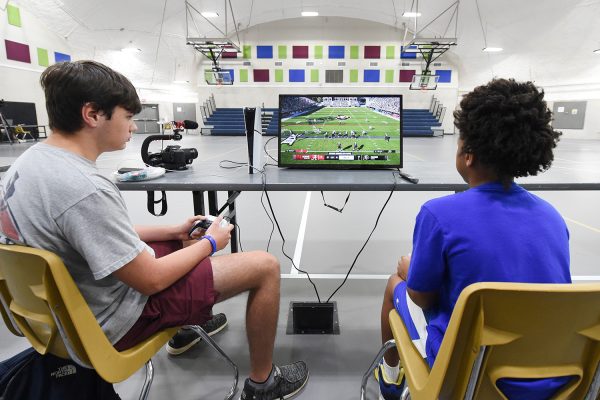Iowa football believes Brian Ferentz coaching quarterbacks is the ‘ideal situation’
After quarterbacks coach Ken O’Keefe stepped down in February to assume an off-the-field role, Brian Ferentz added that title to his offensive coordinator responsibilities.
Iowa quarterbacks Spencer Petras and Alex Padilla walk onto the field during an Iowa football open practice at the Hansen Football Performance Center in Iowa City on Tuesday, March 29, 2022. Petras and Padilla both started for the Hawkeyes in the 2021-22 season.
March 30, 2022
Brian Ferentz played on the offensive line during his time as a Hawkeye and has coached tight ends, running backs, fullbacks, the O-Line, and served as run game and offensive coordinator since joining the Iowa football team’s coaching staff in 2012. Over the last month, though, the sixth-year offensive coordinator has entered some unfamiliar territory.
After quarterbacks coach Ken O’Keefe stepped down in February to assume an off-the-field role, Brian Ferentz added that title to his offensive coordinator responsibilities.
When he was introduced as Iowa’s offensive coordinator in 2017, Brian Ferentz said he would have “almost zero comfort coaching quarterbacks at the moment.” After spending time leading the offense and learning about the position from O’Keefe, the 39-year-old knows he still has a lot to learn but feels confident in his ability to lead Iowa’s quarterbacks room.
“If you’re going to do what I do and coordinate the offense, that’s probably the best, most ideal situation,” said Brian Ferentz, who noted he will continue to lean on QB experts for insight as he adapts to coaching the position. “I’d be lying if I said I didn’t have my eye looking toward that. Hopefully I’ve been looking at it for a little longer than 30 days … I’ve coached a lot of positions on both sides of the ball. I’ve been around football my whole life and the one thing I learned, the one thing I’m sure of at this point is football is football. It’s a simple game. But man, I got a lot to learn.”
Brian Ferentz said he observed how quarterbacks were coached over his first five seasons as Iowa’s offensive coordinator.
Coaching quarterbacks seemed “inevitable,” Brian Ferentz said, if he was going to coordinate an offense. When O’Keefe stepped down, Iowa head coach Kirk Ferentz said his initial thought was not to bring in an outside hire with experience coaching the position. Instead, he hired former Hawkeye linebacker Abdul Hodge to coach tight ends and moved his son, Brian, over to quarterbacks coach because it made “perfect sense.”
“Personally, I think if he can get that situation, it’s better,” Kirk Ferentz said. “And Brian is more than capable of doing that job. And he knows our offense better than anybody, quite frankly. I think it’s going to be a good, positive move for us.”
RELATED: Iowa football notebook | Hawkeyes kick off spring practice
Iowa quarterback Spencer Petras, who has started 19 games as a Hawkeye, said he was “really happy” when Brian Ferentz took over as quarterbacks coach. Petras said that was his preference after O’Keefe stepped down.
“If there’s two people that need to be on the same page,” Petras said, “it’s the offensive coordinator and the quarterback.”
Petras is one of three signal callers competing to be Iowa’s starting quarterback in 2022.
Petras, a senior, has spent the better part of two seasons as a starter for Iowa, including in the Big Ten Championship Game and Citrus Bowl last season. Alex Padilla started three games in 2021 as a sophomore, while Joey Labas has not appeared in a game for the Hawkeyes in his one season with the program.
Brian Ferentz said that coaching quarterbacks has him “more excited about football than I have been in a long time.”
“I’m awe-struck by what these guys are capable of doing,” Brian Ferentz said. “If you really put a clock on it, a lot of these guys are making decisions that are measured in tenths of a second, and I’m talking about big decisions that can change the outcome of a game, a season, a career. … That’s a lot of fun.”
Kirk Ferentz and Brian Ferentz both said that it is an open competition at quarterback. At the start of spring football, though, they said it is too early to say much about who will be under center this fall.
Petras is listed as the starter on the spring football depth chart, while Padilla is marked down as the backup and Labas is third-string.
“Right now Joey Labas is the most popular person in our football program,” Brian Ferentz said, referring to fans always wanting to see the backup play when the starter struggles. “And he will be until he plays. And then it will all change. Alex Padilla was pretty popular for a while. And then he messed up by going in the game. The minute you go out there and you do what you do, you’re going to open the door to that criticism. And that’s absolutely fair. That’s what we do.”
Brian Ferentz takes over a QBs room with room for improvement.
Iowa’s offense ranked 121st out of 130 FBS teams’ last season. The Hawkeyes ranked 99th in the nation in points per game and 109th in passing offense. Iowa has ranked at the bottom of the Big Ten in completion percentage over the last two seasons. The Hawkeyes are currently working through 15 spring practices, which Brian Ferentz called his favorite time of the year. He said this portion of the football calendar is all about reviewing tape, practicing, and working as a team to get better without the pressure of games.
While doing all that, Brian Ferentz said his biggest fear as he transitions to quarterbacks coach is that when a player makes a mistake, he knows how to correct it.
“I think the scariest part of being a coach,” Brian Ferentz said. “I can walk in there and I know where the ball should go. I hope so, otherwise I’d be really bad at my job. And I may be, I don’t know. But I know where the ball should go. Can I communicate in a way that’s not just, ‘Hey, the ball should go here?’ But why, how, fundamentally how they can get it there.”















